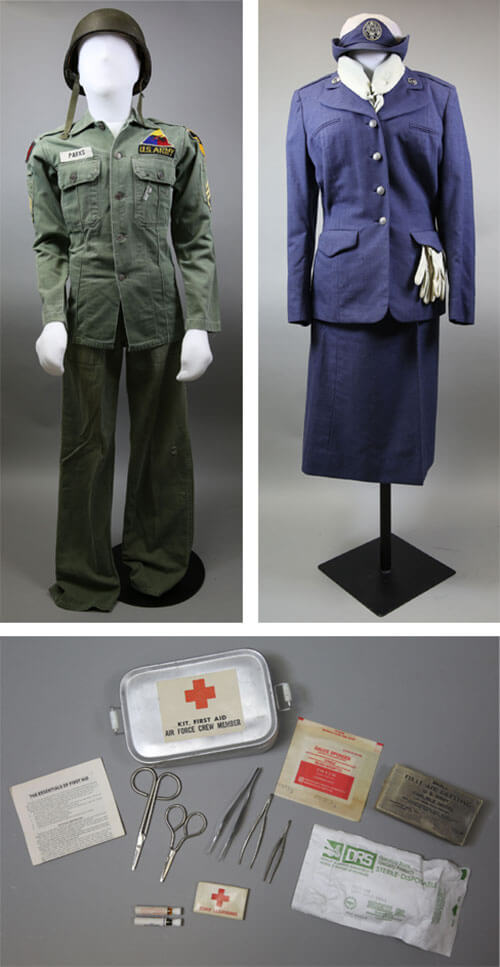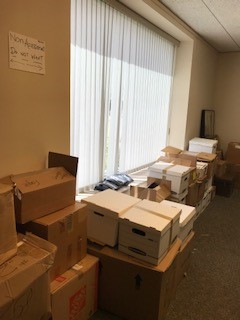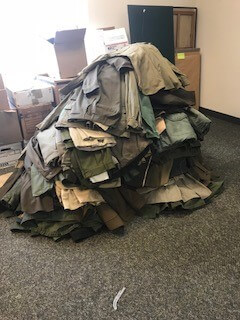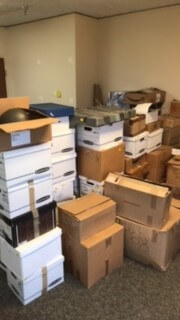Finding Clarity in Chaos | June 29, 2018

Processing the National Korean War Museum Collection

Natalie Walker is Museum / Archives Technician at the Truman Library Institute and is currently finishing a Master’s in Public History at Colorado State University.
Natalie wrote the following blog post telling the behind-the-scenes story of processing a new collection of Korean War items acquired when the National Korean War Museum closed its doors.
Chaos
In December of 2017, the Harry S. Truman Library and Museum acquired the entire archival and museum collection belonging to the now defunct National Korean War Museum (NKWM) in Illinois.
A Mayflower truck arrived at the Library on a cold morning with nearly 10,000 pounds of material haphazardly stored in cardboard boxes, plastic totes, and garment boxes. Archives and museum staff helped offload the truck and stack the hundreds of boxes in empty offices in the Library. Two rooms filled from wall to wall served as the temporary location for the material and would eventually become the initial processing areas for the artifacts and documents as well.
With a deadline to have the rooms emptied by late May of 2018, Museum Technician Stephanie Rohr and I began sorting through the boxes, under the supervision of Archivist David Clark. We quickly learned that a tote carrying archival material might also contain a wadded up pair of olive drab army pants, air force uniform ties or a pair of field glasses. With each box opened, we uttered gasps of surprise, excitement, or sighs of confusion. Why would priceless photographs of the wartime experience be loosely thrown at the bottom of a box with decommissioned grenades and spent shell rounds? Stephanie and I later referred to this initial processing experience as the “chaos” stage.
Wielding sharpies and box cutters, we began sorting through each box, making note of potentially interesting artifacts on the outside of the boxes. We simultaneously separated archival material from the artifacts. After a couple of days spent evaluating the artifacts in the first room and feeling like we had made little progress, Stephanie and I decided to refine our processing procedure. We returned to the room with notepads and began labeling the boxes with numbers and then recording the box number and all of its contents in the notepad. This process took longer, but it allowed us to have a better grasp on the collection as well as the accessioning process of the NKWM.
Most of the artifacts consisted of uniforms from every branch of the military and other related artifacts like mess kits, field glasses, walkie-talkies, c-rations, entrenching tools, dog tags and can openers. Mixed in with these artifacts were Korean items such as kimonos, slippers and brass cutlery, most of which the NKWM staff purchased from retail websites to dress out their exhibits on Korean culture and life. Stephanie and I immediately rejected most of these items noting that they were not authentic to the time period, and in many ways, emphasized ethnocentric stereotypes of Korean culture.
Additionally, a significant portion of the collection was comprised of Korean War veteran material. Artifacts and archival material included photos of reunions, coffee mugs, shot glasses, caps and commemorative medals. Naturally, these items were not considered for accessioning as they focused on commemorating rather than exploring the wartime experience.
Refining
 The process of separating the Korean and veteran material proved a valuable lesson for Stephanie and I as we began evaluating the collection in terms of what the Library should and should not keep.
The process of separating the Korean and veteran material proved a valuable lesson for Stephanie and I as we began evaluating the collection in terms of what the Library should and should not keep.
Our initial processing procedure gave us some control over the collection, but as we opened more boxes and found puzzling artifacts that complicated the sorting process, we realized the need for better criteria to evaluate the artifacts. We started by separating the artifacts into “accessioned” and “non-accessioned” piles based on the accession numbers or lack thereof given by the NKWM. From there, we refined the evaluation process even more so we could specifically identify candidates that the Library might accession.
Stephanie I drafted a list of criteria which we used to evaluate each object. The artifact would need to meet each of the criterion for it to be considered for accessioning. With each artifact, we asked ourselves: Is the item time period, that is, does the artifact fit within the 1950-1953 time period while Truman was in office during the Korean War? Is the artifact exhibit quality? For this criterion we focused on the overall condition of the artifact. Next, we questioned whether or not the artifact had a narrative? Could we tell a compelling story with this artifact? A mess kit, for example, would contribute to a miniature exhibit on camp life that might include artifacts such as c-rations and can openers, as well as sleeping bags and clotheslines.
Although we maintained the “accession” pile and “non-accession” pile, we were able to further consolidate the artifacts based on the evaluation criteria, which helped us identify potential candidates for accessioning. Slowly but surely, the two rooms, which at first felt daunting, disorganized and chaotic, became more manageable. We frequently joked, “Look, you can see the floor!”
After several weeks of processing and sharing our findings with staff members, I suggested that we draft a report detailing the entire processing procedure. Stephanie and I spent several weeks updating the document with our discoveries, our recommendations and our observations regarding the collection.
 Emboldened by our progress and our ever-increasing grasp on the state of the collection, Stephanie and I returned to the now organized rooms and began tackling the most daunting aspect of the collection: uniforms. We decided to separate the uniforms based on each military branch. Once completed, we had over 70 boxes of uniforms, most of which consisted of army clothing. While processing the uniforms, we learned that they comprised nearly 75% of the artifacts.
Emboldened by our progress and our ever-increasing grasp on the state of the collection, Stephanie and I returned to the now organized rooms and began tackling the most daunting aspect of the collection: uniforms. We decided to separate the uniforms based on each military branch. Once completed, we had over 70 boxes of uniforms, most of which consisted of army clothing. While processing the uniforms, we learned that they comprised nearly 75% of the artifacts.
It was during the “refining” stage of our process that Stephanie and I selected potential items for accessioning and began storing them in one of the previously packed offices. We decided to use this room as a temporary display where the Truman Library Institute board members, as well as the Library staff, could view the interesting and valuable artifacts. After weeks spent sorting boxes and often feeling frustrated by the chaotic state of the collection, Stephanie and I were thrilled to share our progress and find some clarity in the process.
Clarity
By the time we had processed the last box, we were able to narrow down the potential candidates for accessioning to approximately 60 items. This came as a bit of shock considering the collection initially filled two large offices. Yet, as Stephanie and I discovered during the processing, many of the artifacts did not meet our stringent, but essential, accessioning criteria, while many more did not fit the museum’s established collecting policy.
The artifacts that did not make the cut are safely and securely stored on site and await further processing. While there are no official rules for further processing, most likely this process will involve contacting donors or other cultural institutions to gauge their interest in acquiring the items not chosen for accessioning by the Truman Library.
Although we began with thousands of artifacts, Stephanie and I both felt that our careful selection process remained consistent with museum best practices. Additionally, we ensured that the chosen artifacts would contribute to a more diverse, holistic exhibit on the Korean War, one which museum and archives staff alike look forward to with the upcoming renovation.
Stephanie and I learned valuable lessons during this processing, including how to tell if a grenade has been decommissioned and that not all artifacts are created equal. Joking aside, we learned important steps in the evaluation process and that defining and then refining criteria are essential steps in collection evaluation.
Walking into that first room and navigating through the maze of boxes, I remember feeling overwhelmed and thinking that we might never finish. Even more disconcerting, neither Stephanie nor I fully understood what exactly it was we needed to accomplish. Yet in the course of two months, we devised a process, refined it, and produced what I unashamedly will call impressive results. Most importantly, we found clarity in chaos.
Join our email list to receive event updates and the latest Truman news right in your inbox:



